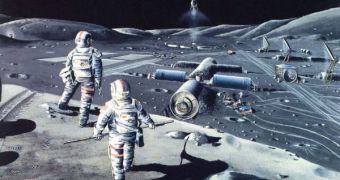The American space agency could have its plans of returning humans to the Moon by 2020 thwarted by the fact that the lunar surface is constantly pounded by cosmic radiation and solar flares, which are a real and serious danger to astronauts. During previous missions, travelers to Earth's natural satellite were exposed to these radiations, but only for limited amounts of time, which was deemed to be an acceptable risk at the time. However, with the new missions, the agency plans to keep astronauts in outposts for several months at a time, so the protection against radiation is a fundamental requirement.
In an attempt to get fresh insight into how it could protect future lunar outposts from harmful radiation, NASA has asked students around the world to contribute ideas. North Carolina State University (NC State) graduate students have answered the call, by developing a possible method of prevention for protecting the potential bases. The young researchers have thus devised a defense mechanism that basically consists of a high-tech “blanket,” able to both shield the astronauts' living quarters from solar flares and cosmic rays, and also produce energy for the base.
The three NC State students behind the new shield, Michael Sieber, Ryan Boyle and Anne Tomasevich, have all just recently graduated from the university's Textile Engineering program. Their abstract design of the high-tech blanket has been selected as one of the ten projects to have made it in the final of the Revolutionary Aerospace Systems Concepts Academic Linkage (RASC-AL) competition. The contest is sponsored by the American space agency and the National Institute of Aerospace.
“We had many factors to consider in developing this outpost cover – not just being able to protect against radiation. The product needed to be as lightweight as possible to feasibly fit on the transportation module, and have the ability to be easily erected by a minimum number of astronauts for immediate use once landing on the moon,” NC State graduate student Michael Sieber said.
“These obstacles are where our knowledge of textile properties will give us an advantage. This is a competition aimed at aerospace engineering students, but we understand the properties associated with different textile materials, and that gives us unique insight on how to troubleshoot some of these issues,” Project Advisor Dr. Warren Jasper, who is also an NC State professor of textile engineering, added.

 14 DAY TRIAL //
14 DAY TRIAL //